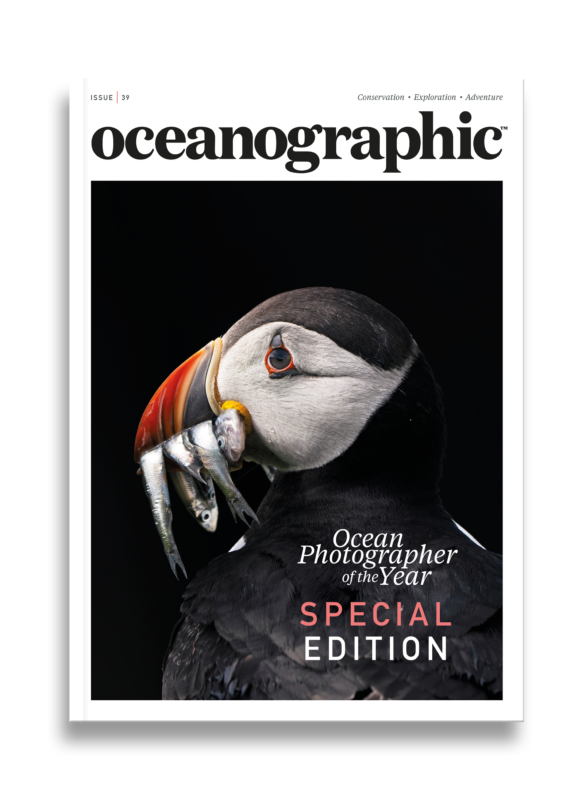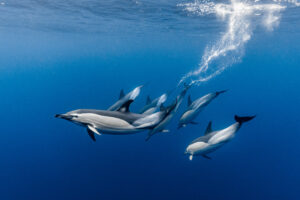Curse of the conch
In Honduras, the Edges of Earth expedition goes on the hunt for the Caribbean conch to find out more about the species' conservation status.
Navigating through the dense mangroves, we swiftly moved out of sight as the boat traffic dwindled. Departing from the renowned diving spot, West End in Roatan, Honduras, we ventured further into these serene waters. At the helm was Dago, a local expert with an impressive understanding of the region, propelling us forward with urgency. His mission was clear: reach Man-O-War Caye without delay. A call on his pocket radio had alerted him to potential illegal activity in the vicinity.
For the first time in Honduras, we found ourselves completely alone on the water, no other boats in sight. We relished the momentary solitude but were also aware that our arrival at the Caye might hold unpleasant surprises. The uncertainty of what awaited us added another layer of tension. Hearing the term ‘illegal activity’ from a maritime patrol team typically suggests an impending altercation on the horizon. In this case, we were most likely dealing with an instance of illegal fishing activity.
In Roatan, this type of thing is a common issue. Roatan is a popular scuba diving destination known for its vibrant coral reefs and marine biodiversity. However, this popularity also puts immense pressure on local marine resources. The island’s economy relies heavily on tourism, which has led to increased demand for seafood, including even the protected species. This demand results in frequent violations of fishing regulations.
Fishermen are often caught harvesting protected species such as lobsters and parrotfish. The patrol team diligently searches for those violating the rules of the Roatán Marine Park (RMP), as well as those fishing out of season, catching undersized animals, or collecting juveniles. These activities not only breach regulations but also threaten the delicate marine ecosystem. The RMP monitors and protects Roatan’s 130 km of coastline, operating five patrol boats seven days a week during daylight hours. Occasionally, they also conduct night patrols when necessary, making this a full-time, around-the-clock effort. Supported by the Honduran Navy, the team typically searches for species labeled as ‘caution’ or ‘do not consume’, on the local Responsible Seafood Guide, ensuring the protection of these vulnerable marine inhabitants.
‘Caution’ species include those with specific restrictions. For instance, lobsters must have a minimum tail length of 5.5 inches (14 cm) to be caught and are subject to a closed season from March 1st to June 30th to allow populations to reproduce. On the other hand, “do not consume” species are those that are overfished, listed as vulnerable or endangered by the IUCN, illegal to fish in Honduras, and/or vital to the overall health of the reef system surrounding Roatán. This category includes species such as groupers (of almost all varieties), sharks, and turtles.
The RMP has created a seafood guide to help resorts, retailers, and consumers make informed choices about their seafood consumption—as many tourists visiting Roatan are unaware that every choice they make can have a positive or negative impact on the reef. This guide aims to educate seafood and dive enthusiasts on making smart choices, thereby reducing the demand for “do not consume” seafood and contributing to the preservation of the marine ecosystem.
As we approached Man-O-War Caye, we were greeted by lush seagrass and pristine white sands. The only sounds were the rustling of palm trees and the gentle lapping of waves against the mangroves. The island was completely deserted, and at first, it seemed totally void of any human activity. However, upon closer inspection, we noticed something else which indicated there was human destruction: conch of all sizes lining the shore.
The island was covered in empty conch shells, each displaying vibrant hues of bright pink and orange that were both captivating and beautiful. Despite their allure, this was quite literally a conch graveyard. We each set off in different directions, examining the sizes of these conches to understand the extent of the situation. To our dismay, most of them were juveniles – far from reproductive size.



Conch are a type of sea snail, specifically marine gastropod mollusks, and are renowned for their beautifully spiralled shells. The shells are often used as decorative items and even historically, as tools and trading currency in various cultures. The term “conch” typically refers to species in the family Strombidae, with the Queen Conch (Lobatus gigas) being the most recognised. These creatures inhabit warm waters such as the Caribbean Sea, the Gulf of Mexico, and the western Atlantic Ocean. They play a crucial role in marine ecosystems, acting as grazers that help maintain the health of seagrass beds and control algal growth.
Conch hold significant ecological, cultural, and economic value in many Caribbean communities where conch meat is a dietary staple and a crucial source of protein. Their shells are fabricated into local handicrafts and sold as souvenirs, bolstering the tourism economy. However, conch face numerous threats, primarily from overfishing and illegal harvesting driven by high demand for their meat and shells. Habitat degradation, especially the destruction of coral reefs and seagrass beds, also pose significant risks. These pressures have led to declining conch populations in many areas, prompting conservation efforts and regulations to manage and protect these unique marine snails.
In Honduras, conch harvesting is permitted due to its significant cultural importance to local communities – however in the Bay Islands they are protected. This doesn’t mean that they are not targeted by local fishermen. As the tourism boom has taken over the island, with approximately 1.6 million people visiting per year, conch harvesting is a big driver within hotels, restaurants, and other establishments that attract guests from all around the world. To ensure sustainability and conservation, conch must be purchased from legally registered providers that source the meat hundreds of miles away from the Bay Islands using industrial fleets. This regulatory framework helps maintain the population levels of conch in the region, preventing overexploitation.
But as you might expect, and as we observed firsthand on Man-O-War Caye, not everyone is going to follow the rules. The discarded conch shells, with their vibrant interiors, had punctures in their spirals where poachers removed the conch meat. They do this to minimise damage to the shell, allowing them to be sold or used for other purposes. Unfortunately, these juvenile shells, which are illegal to harvest in all circumstances, were discarded as they hold no value. And this is exactly how conch graveyards are formed.
Dago explained that 12 of these small shells make up just one pound of meat – a tiny amount worth only $7. It’s a futile and ultimately unworthy desecration of these shells (which cannot be used for anything) for such a tiny amount of meat harvested. Worse still, this over-harvesting is a significant reason for the decline in conch populations in the Caribbean, creating a snowball effect in harming the fishing communities. It’s a vicious cycle: conch try to reproduce, juveniles are harvested too young, and there aren’t enough mature conch left to sustain the population.
Efforts to address over-harvesting include establishing Marine Protected Areas and enforcing stricter regulations, as the RMP has been doing for years. When illegal conch activity is detected, they relocate the conch to deeper waters to make retrieval harder for fishermen. However, this is only a small and temporary solution. Many Caribbean nations struggle with inadequate enforcement resources, lacking sufficient funding to employ more patrol officers. It wasn’t until 2023 that Honduras “announced a national stance on ocean management,” per Pew Charitable Trusts.




Without significant intervention, the conch could face extinction within the next few decades – a concern weighing heavily on everyone at the RMP. This urgency drives Dago and his team to work tirelessly, despite their limited resources, to protect the remaining conch. Dago has dedicated 10 years to this demanding and sometimes dangerous role, fuelled by his commitment to the cause. As he put it, “there’s no other job for me than this.”
As I paced back and forth on the island, picking up shell after shell, marvelling at their beauty and longing for a means to assure their long-term survival, I couldn’t help but wonder: what more can we do? The truth is, I’ve eaten conch before. When I was younger and vacationing in the Caribbean with my family, this topic wasn’t something we encountered at resorts or among the locals – it wasn’t even something we knew about. There were no signs, no indicators, and no narratives around limiting conch consumption. In fact, given its cultural significance throughout the Caribbean, eating conch was widely celebrated and it wasn’t considered vulnerable at the time.
But times have changed. In Roatan, this is pretty heavily advertised, as countless divers from around the world seek to experience the flavours of Caribbean culture. As consumers, travellers, tourists, explorers, and divers, we have an obligation to understand where our seafood comes from, what the rules and regulations are in the countries we visit, and to make informed decisions accordingly – if we want to keep eating seafood as part of our diet.
We aren’t going to get it right every time. Striving to be ‘climate perfect’ versus “climate trying” are two very different approaches. Accepting that we won’t have all the answers is crucial, but actively making an effort to do the right thing is what matters most. It helps us get educated, learn from our mistakes, and do better now and in the future. This is the lesson we learned as we moved from one juvenile conch pile to another on Man-O-War Caye.
What we’ve discovered exploring the Caribbean is how crucial the balance truly is. Communities rely on conch for survival just as much as the ocean does too. Achieving this balance is easier said than done, but the RMP works every day to find that perfect harmony between the people who call Roatán home and its ocean ecosystems and creatures. Any small step toward conserving and restoring these populations is valuable, but more time, resources, teams, and effort are needed.


For me, the conch graveyard is perhaps one of the most memorable freeze-frames from our expedition so far. The totally futile carnage laid out over the span of that beach all in an effort to seize incredibly tiny sums of conch meat. And while it’s easy to look at that situation and scoff at the destruction alone, it also represents the desperation of the people who committed it to find a means to an end as fishermen. And therein lies the crux of this issue: finding a balance between the many different issues at play in these precarious environmental and socioeconomic situations. Fortunately, we can turn to dedicated individuals like Dago, and the work done by the RMP to guide our way to more balanced future together.
Printed editions
Current issue
Back issues

Back Issues
Issue 41 Holdfast to the canopy

Back Issues
Issue 39 Special Edition: OPY2024
Enjoy so much more from Oceanographic Magazine by becoming a subscriber.
A range of subscription options are available.










